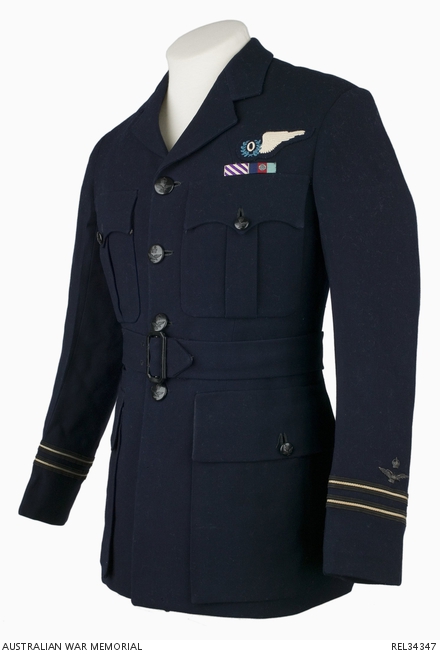| Places | |
|---|---|
| Accession Number | REL34347 |
| Collection type | Heraldry |
| Object type | Uniform |
| Physical description | Cotton, Cotton sateen, Oxidised brass, Plastic, Wool barathea |
| Maker |
Leon Fonstein |
| Place made | Egypt: Cairo |
| Date made | c 1942 |
| Conflict |
Second World War, 1939-1945 |
Winter service dress tunic : Flight Lieutenant T E W Howes, RAAF, 70 Squadron RAF


RAAF blue officer's winter service dress wool barathea tunic with a pair of pleated breast patch pockets and a pair of expanding patch waist pockets. The pockets have flaps secured by black plastic RAAF buttons. The flaps on the breast have three points, while those at the waist are square. The ribbons of the Distinguished Flying Cross and the 1939- 1945 Star with rosette are sewn above the left hand breast pocket. Above these is a white and blue embroidered Observer's wing (brevet). The rank insignia of a Flight Lieutenant is carried on each lower sleeve, along with an oxidised brass eagle and crown. Above these on the right sleeve are four red chevrons indicating four years service. The tunic is lined with dark blue cotton sateen, with an inset breast pocket inside the proper left side, and is closed by four large black plastic RAAF buttons. The sleeves are lined with white cotton sateen finely striped in black. The self fabric waist belt has a black plastic buckle with two metal claws. It is sewn to the back of the tunic waist rather than being secured by keepers. There is a back vent extending from the centre back waist to the bottom of the tunic skirt. A cream ribbon manufacturer's label with woven brown lettering is sewn inside the back neck and reads, 'Leon Fonstein Le Caire'. Beneath is a broad white cotton tape marked in Indian ink 'F/Lt T.E.W HOWES'.
Related to the service of 404900 Thomas Edward White Howes. Employed by Qantas Airways, Brisbane before the war, he enlisted in the RAAF on 6 December 1940 aged 18. He trained in Australia and in Canada as part of the Empire Air Training Scheme (EATS). After training he embarked for the United Kingdom, where he completed his training as a navigator, flying in Wellington bombers in January 1942.
Howes was commissioned as a Flying Officer on 15 March and was assigned to 70 (Wellington) Squadron, RAF in the Middle East later that month. The squadron was equipped with Vickers Wellingtons based at Qotafiyah, Egypt. His first mission on 28 April was against German supply shipping anchored at Benghazi. With targets ranging from shipping and airfields to road convoys and supply dumps, Howes flew 13 night missions through May and June 1942.
During a night attack on German transport in the Ras El Kanyis area on the night of 25 June after bombing the column of vehicles, Howes' Wellington, piloted by Flight Sergeant Stewart, returned for a number of strafing runs, with the Second Pilot, Sergeant Brown and Wireless Operator, Sergeant Calvert operating the bomber's two beam guns. They were surprised by an enemy fighter which raked the sides of the aircraft with cannon fire, setting electrics on fire and wounding three of the crew. For his actions in dousing the fires and retrieving the burning rear gunner, Sergeant Wagner who had lost a leg, and attending to his crew's wounds with morphia, Flying Officer Howes was awarded the Distinguished Flying Cross. A photograph of the Wellington being retrieved the next day shows sections of the fuselage completely burned through, revealing the geodesic structure. Wagner later died of his injuries.
The squadron moved northwest of Cairo in the wake of the allied retreat. Howes later transferred to 104 (Wellington) Squadron, RAF and having flown 44 operational missions, it appears that he took on a navigator training role with 203 Group.
He was promoted to Flight Lieutenant in September 1943 before moving to RAF Aquir in Palestine, (south of Tel-Aviv). On 6 May 1944 Howes embarked for Australia, arriving on 4 June. He was transferred to the RAAF Reserve on 16 March 1945, enabling him to rejoin Qantas. He remained with the RAAF Reserve until at least the late 1950s. During the Vietnam War, he served as a navigator on the Qantas ‘Skippy’ troop flights to and from Vietnam.
Related information
Conflicts
Subjects
People
Related Objects
- 'Mae West' 1941 flap life jacket : Flight Lieutenant T E W Howes, RAAF, 70 Squadron RAF
- Winter service dress trousers : Flight Lieutenant T E W Howes, RAAF, 70 Squadron RAF
- Souvenir pennant : Corporal T E W Howes RAAF, Empire Air Training Scheme
- RAAF Pattern 37 water bottle with attached clasp knife : Flight Lieutenant T E W Howes, RAAF, 70 Squadron RAF
- Forage cap : Flight Lieutenant T E W Howes, RAAF, 70 Squadron RAF
- Ear drum defenders [ear plugs] : Flight Lieutenant T E W Howes, RAAF, 70 Squadron RAF
- Signal mirror : Flight Lieutenant T E W Howes, RAAF, 70 Squadron RAF
- Rolls Razor Imperial No 2 shaving set : Flight Lieutenant T E W Howes, RAAF, 70 Squadron RAF
- Water sterilizing outfit : Flying Officer T E W Howes, RAAF, 70 Squadron RAF
- Medical first aid supplies stored in Boiled Sweets tin : Flight Lieutenant T E W Howes, RAAF, 70 Squadron RAF